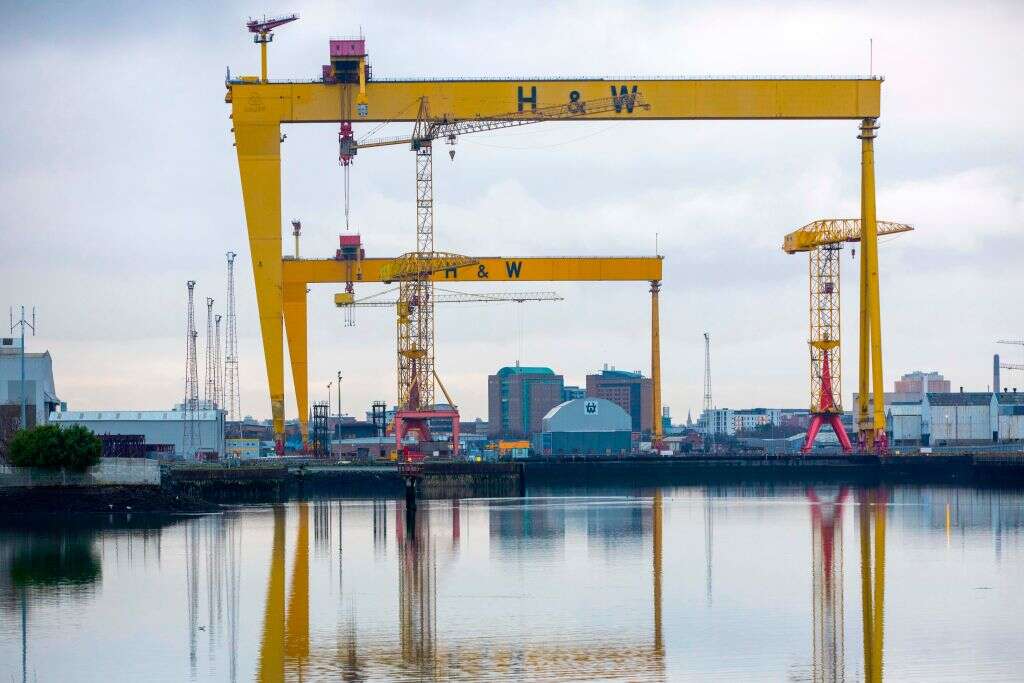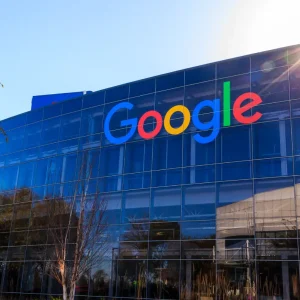
The morning after members of the loyalist community cried foul at the European Union and Sinn Féin, setting cars ablaze and ransacking businesses on the streets of Carrickfergus and Derry, Seamus Leheny prepared to address a delegation of US businessmen, politicians and diplomats on why the Northern Ireland Protocol was worth defending.
“The US has an interest,” explains Logistics UK’s policy manager. “They oversee the Good Friday Agreement. They want to make sure peace and prosperity are upheld in Northern Ireland – that nothing is going to incite any issues and jeopardise peace and prosperity.”
Nobody here wanted the Protocol but it was better than a hard Brexit and no solution.
Seamus Leheny, Logistics UK
The Protocol was designed to preserve the ‘spirit’ of the Good Friday Agreement, which states that no hard border should be re-imposed between the UK and the Republic of Ireland after Brexit. It ensures that the six counties remain in the European Single Market – meaning that many goods now being imported or exported out of Northern Ireland’s ports are now subject to EU customs checks.
The precise terms of the Protocol were only agreed upon, however, in December 2020, leaving businesses on both sides of the new sea border with little time to comply with the new customs regime. Disruption unsurprisingly ensued when the new system began the following month, with countless shipments being held up or denied entry entirely for want of the proper forms (overall goods exports from the UK to the EU that month sank by 40%.) Despite this, the Protocol retained broad – if reluctant – support in Northern Ireland. “Nobody here wanted the Protocol,” says Leheny, “but it was better than a hard Brexit and no solution.”

That changed by the end of January, when the EU abruptly invoked an article of the protocol that allowed for part of it to be suspended in an emergency situation – in this case, preventing Covid-19 vaccines from being exported to the UK. The resulting furore soured unionist support for the trading arrangements, which they saw as the EU exerting undue power over the lives of Northern Irish citizens. “They think that the Protocol, and the language of the Protocol, basically puts the union at risk,” explains Professor Katy Hayward of Queen’s University Belfast. One DUP MP subsequently called for “guerrilla warfare” against the new arrangements.
This grievance is one of many fuelling the riots currently gripping Northern Ireland’s major urban centres and has shone a spotlight on the continuing disruption the country’s businesses face in coming to terms with the most post-Brexit settlement. The situation is a microcosm of the vast new challenges the UK has assumed in facilitating seamless commerce with its nearest trading neighbour – challenges, many assumed, would be met by technology that would make the movement of goods more efficient.
Implementing the technology to support the ‘smart border’ between the UK and Ireland is an IT project with the highest possible stake. Getting it wrong could mean a return to a hard border in Ireland, and perhaps the bad old days of sectarian conflict. Solving the problem, however, could see the Protocol serve as an example for the whole world to follow.
Teething problems with Northern Ireland border technology
The UK government and its supporters have always seen border technology as the key to complying with the GFA and attaining seamless trade in a post-Brexit world. The (still-incumbent) Conservative Party’s 2017 General Election manifesto implied as much, committing to ‘maintain as frictionless a border as possible for people, goods and services between Northern Ireland and the Republic,’ something that would be made possible by a network of unmanned border posts and automatic number plate recognition cameras.
That was thrown into doubt when the UK Parliament repeatedly voted against Prime Minister Theresa May’s deal. Still, prominent Conservatives continued to champion technology as a way to smooth over any concerns for the border. Shortly before succeeding May in 2019, Boris Johnson said that if Nasa “could use hand-knitted computer code to make a frictionless re-entry to Earth’s atmosphere in 1969,” then the question of seamless trade on the Northern Irish border could also be solved – after previously comparing the technical challenge to that of collecting the London Congestion Charge on the boundary between Camden and Westminster.
This has not matched the reality on the ground. Although the protocol shifts the burden of checks away from the land border to Northern Irish ports, businesses in the six counties are still struggling to adapt to the new documentation requirements for customs. This is partly a knowledge problem, a lingering consequence of the fact that “we got information so late in the day,” says Hayward.
That issue has partly been addressed by the clearest manifestation of the UK government’s technological commitment to the Northern Irish border so far: the Trader Support Service. A combined online and telephone advice centre for businesses about the protocol, it claims to have processed some 337,000 consignments since January. Its reputation among businesses in Northern Ireland remains mixed. “No doubt, if we didn’t have it, there would have been huge problems,” says Leheny. Even so, argues Hayward, “it’s taken them a long time to realise just the complexity of it all,” with some hauliers complaining to a parliamentary select committee that while the agency’s advisers were “pleasant,” they often had “no previous experience” in customs or logistics.
What’s more, while the TSS can advise businesses on how the protocol affects them, it can’t pay for the new administrative obligations that have arisen for businesses in Northern Ireland. Those businesses that can, have started mimicking their counterparts in Great Britain by “spending a lot more money” on new IT systems to help deal with the administrative burden of the new customs regime, says Leheny. “If I look on jobs websites for logistics, nearly every company is looking for admin staff.”
Others have diverted their supply chains entirely. “You’re having businesses that, maybe, would have gotten their cured meats and cheeses from a broker in London,” says Leheny. “Now they’re going and dealing with a broker in Paris, and taking them into Northern Ireland directly from France.”
For the moment, easements on certain checks have helped to reduce the disruption. These, however, are set to expire by autumn. It remains unclear whether customs officials will necessarily be able to cope when the Protocol is fully implemented, with the number of checks on agrifoods alone estimated to rise 30,000 per day.
What would make this task easier, says Leheny, is if both jurisdiction’s IT systems for managing SPS systems could actually talk to each other. “At the moment, you can’t raise an export health certificate in the UK and for it to transmit, seamlessly and electronically, across into Traces,” he says.
Doing so would require building an entirely new API. One of the last nations to build one with the EU was New Zealand, in a bid to ease the export of lamb products. While this served as a valuable technical precedent, it took two years to agree on how the API would work. Defra, the UK agency responsible for overseeing SPS regulations, claims it can have a similar system up and running within eight to ten weeks.
Then there’s the issue of duties. If a business in the UK exports goods into Northern Ireland, for example, and those goods are considered at risk of being distributed into the EU, then the business is required to pay EU tariffs. However, if the business can prove that the goods were only distributed in Northern Ireland, the UK government will reimburse those tariffs.
“There are two problems there,” says Hayward. One is that there isn’t a hard and fast way of necessarily proving that such goods didn’t get distributed over the border into the Republic of Ireland. Secondly, “we don’t have that system up and running, yet, for reimbursement,” meaning many businesses in the UK and Northern Ireland are out of pocket.

Frictionless trade through technology on Northern Ireland border
The UK government has promised that new guidance on tariff reimbursement will be issued shortly. In the meantime, many businesses on both sides of the Irish Sea have been forced to reconsider whether their supply chains are better placed in the EU than in Great Britain. Logistics UK estimates that up to 48% of businesses in Northern Ireland have had to cancel or delay journeys thanks to the new customs regime. Dismay among loyalist communities and unionist politicians about the Protocol have also created uncertainty that the agreement will even hold.
Leheny believes that it will. “The key thing about the Protocol is that it’s not a completed article – it’s still a work in progress,” he says. “It’s a bit like when you get a new pair of shoes: you have to wear them in for a while.”
Practically, that means tempering expectations about the speed at which technology can solve the problems raised by the Protocol. The IT and surveillance systems required to process customs declarations more efficiently will take months, if not years, to bed in. Others, like audited movement systems, already exist on the frontier between Sweden and Norway. While trade associations including Logistics UK advocate for such a framework as a way of reducing the burden of checks on hauliers, it is important to remember that the context for its deployment in Scandinavia was entirely different.
“The thing with Sweden and Norway is that you have this huge border, but trucks are only allowed to transit ten roads,” explains Leheny. Additionally, “Norway is part of the European Economic Area. So, it is very closely aligned to the European Union anyway.”
The ability of the UK government to deliver on such a system remains in doubt. Its track record for border technology innovation is lacking. In March, the Home Office was condemned by a parliamentary committee for the ‘staggering cost’ involved in upgrading its ‘Digital Services at the Border’ programme for monitoring the flow of people, estimating that only one in 15 border staff were trained in its use so far. Meanwhile, businesses across the UK are complaining of a ‘paper border,’ while in Northern Ireland simmering discontent about the new customs regime has led to customs staff being targeted for reprisals by loyalist paramilitaries.
Leheny believes that, eventually, technology will make the kind of difference previously envisioned for the Northern Irish border. As part of its 2025 strategy for the border, the UK government has pledged some £705m to overhaul systems on its frontier, committing to a single trade window for traders and a simplification of checks, and implementing both in Northern Ireland in collaboration with Stormont.
“Things will improve,” says Leheny. Not since the peace process have “you had this many civil servants focused on Northern Ireland,” he says, with the government promising massive new investment in border technologies more broadly, along with the hiring of thousands more customs staff. “They’ve thrown everything but the kitchen sink at this.”
Relations between the EU and the UK over Northern Irish trade have also been improving. “Things have become a bit more constructive,” says Leheny. In return for greater flexibility, the EU has called for a more precise “delivery journey over the next few months of what the UK government will do.”
There is a practical limit, however, to that goodwill. Any adaptions the EU makes to its own customs infrastructure in Northern Ireland would likely be seized upon as justification for other nations in calling for easements for their own trade with the bloc. “Everyone needs to buy into this,” says Leheny of the protocol. The Protocol “won’t look like what it looks like today in a year or two years’ time,” he adds. “It will evolve a little. But, obviously, it has to respect the European single market. That’s the reason it was there in the first place.”
Ultimately, Leheny believes that – should the government actually realise its technological ambitions – the Northern Ireland Protocol could serve as an example for the whole world in managing an intensely complicated trading relationship. In the meantime, though, the prevailing impression is one of an agreement held together by a patchwork of easements that is only adding to the political discontent in the six counties.






